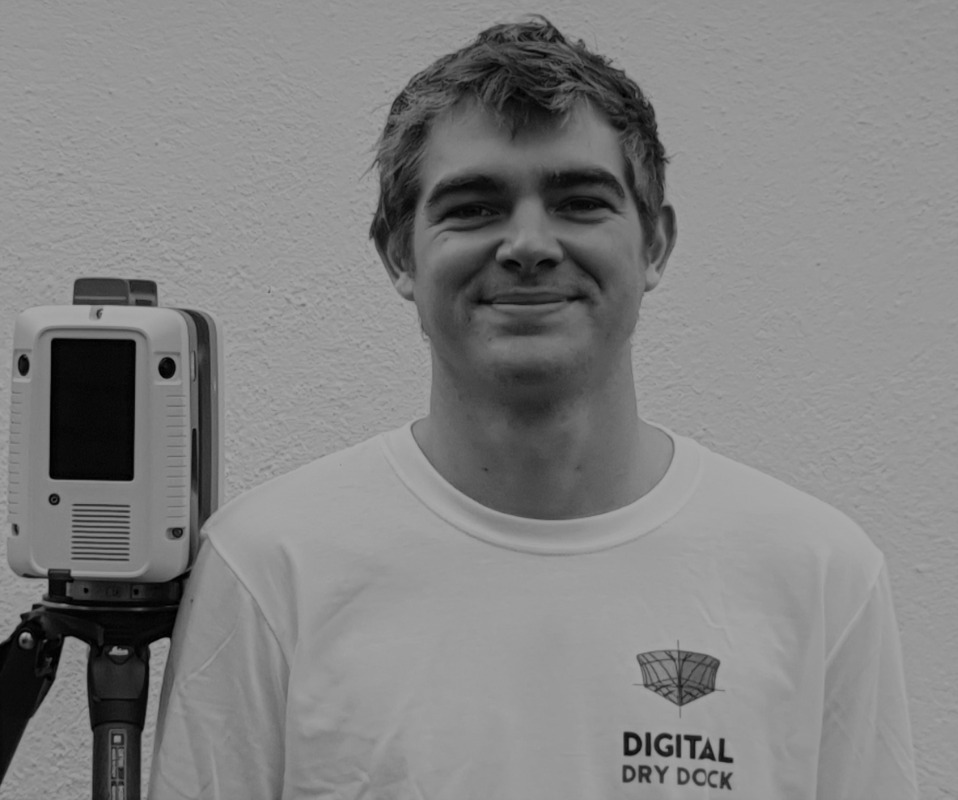Using 3D laser scanners to create fit-for-purpose naval drawings
Naval architect and co-founder of Digital Dry Dock, Oliver Graffy explains how using 3D laser scanners to create accurate digital twins of marine assets can revolutionise the superyacht industry…
When we talk about yacht refits or any form of manufacturing within the yachting industry, our minds are drawn to time out of the water and time in the dry dock. Typically, it takes days to carry out the measuring process alone and, due to the absence of fit-for-purpose ‘as-built’ drawings, failure to measure accurately often leads to poorly estimated projects and costly re-work.
However, with the introduction of 3D laser scanners it is now possible to accurately measure the hull, superstructure exterior, interior and engineering systems in just a few hours.
This technology has already been put to widespread use in the building industry. It is even a legal requirement for government-owned buildings because of the time and cost savings it offers throughout the building’s lifetime. So how does it work? And what value can its use bring to yacht owners?
How does it work?
The process begins with boarding the boat and gathering information. While it is an option to scan the entire vessel, nothing beats the knowledge of the owner, the captain or the crew in knowing where to start. From here, the laser scanning begins.
With the use of laser scanners, photogrammetry and scanning accessories, designed especially for yachts – such as the counterbalance rig which can be suspended over the side – almost any part of the boat above the waterline can be measured while it is still operational and in the water. This means that no matter what is being surveyed, whether a small engineering compartment or even an entire vessel, measurements can be taken while the boat is fully operational. Technology is currently being developed to enable inspections to be completed below the waterline too.
Once the initial scan has taken place, the data is uploaded and the scans are registered together to form the foundation of the digital twin – a point cloud. This three-dimensional data set can then be used to create drawings or models in either 2D or 3D and in any CAD format. Utilising these drawings and dimensional checks, findings are reported, comparisons are made to design drawings and there are checks for misalignment. Next, everything that has been found during the measurement process is depicted in a format which suits the client.
What does this mean?
This is a big move away from the unscientific and labour-intensive techniques being used to date. Traditionally, measurements are taken by hand in 2D and then translated into =a 3D model.
If we take a look at 3D scanning’s capacity to facilitate smarter fairing and finishing, the benefits become immediately clear.
Based on a 50m motoryacht hull, the mapping process can take hundreds of hours to complete. Factor in safety, over-orders and, often, an over-application of filler and it’s time to consider stability and warranty issues too.
Scanning, however, requires one person and a fraction of the time. Plus, the elimination of a large part of the risk. Not only are scanners quicker and safer, but they are also astoundingly accurate. The technology used provides sub-two-millimetre accuracy at a 45m range and it’s often possible to measure within a distance of 10 metres. This accuracy enables us to calculate the exact volume of product required, to the litre, as well as the distribution of filler. Plus, all of this can take place before the yacht reaches the dock.
What are the wider implications for the industry?
3D laser scanning and the resulting ‘digital twins’ have already been used in a number of other ways throughout the industry. For starters, they are having a huge impact on project timelines. Because drawings can be produced remotely and with such a quick turnaround, multiple processes are able to take place at once, compressing the project Gantt chart. For example, templates for joinery can be prepared remotely, while allowing crew or other trades access to the cabin. Furthermore, through the creation of accurate ‘as-built’ drawings, modifications can be manufactured in advance, cutting down the time in refit substantially.
We’ve also seen findings used to document insurance damage or help resolve warranty issues. However, it’s not possible to go into details here due to client discretion and confidentiality.
Even racing has seen the benefits of digital modelling in this way, through the comparison and optimisation of hull shapes, plus rig, keel and rudder alignment.
This method is nothing short of revolutionising the superyacht industry in its ability to save time and money whilst providing a better set of drawings to work from.
NEW: Sign up for SuperyachtNewsweek!
Get the latest weekly news, in-depth reports, intelligence, and strategic insights, delivered directly from The Superyacht Group's editors and market analysts.
Stay at the forefront of the superyacht industry with SuperyachtNewsweek
Click here to become part of The Superyacht Group community, and join us in our mission to make this industry accessible to all, and prosperous for the long-term. We are offering access to the superyacht industry’s most comprehensive and longstanding archive of business-critical information, as well as a comprehensive, real-time superyacht fleet database, for just £10 per month, because we are One Industry with One Mission. Sign up here.
NEW: Sign up for
SuperyachtNewsweek!
Get the latest weekly news, in-depth reports, intelligence, and strategic insights, delivered directly from The Superyacht Group's editors and market analysts.
Stay at the forefront of the superyacht industry with SuperyachtNewsweek




